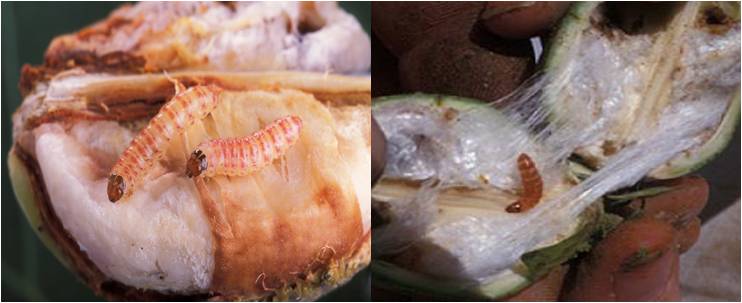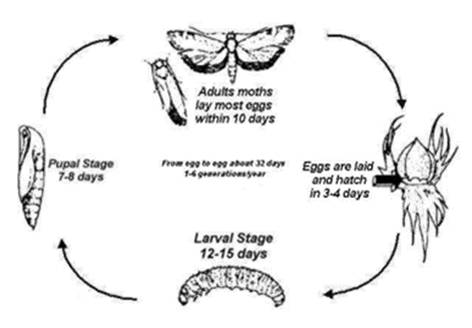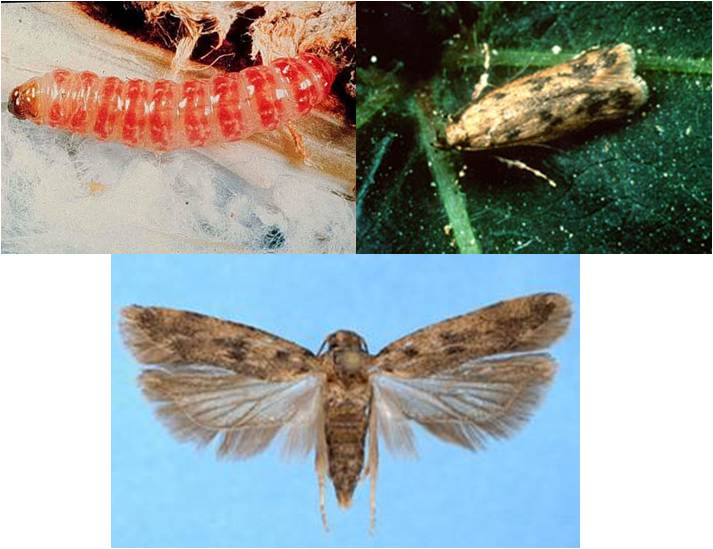|
Pests of Cotton :: Major Pests :: Cotton Pink Bollworm
3. Cotton pink bollworm: Pectinophora gossypiella (Gelechiidae: Lepidoptera)
Distribution and status: India, Pakistan, Africa, Australia, Asia. Major pest
Host range: Cotton, bhendi, holly hock and other malvaceous plants
Damage symptoms
The caterpillars feed on flower buds, flowers and bore into bolls. When they bore into flower buds, they feed on developing anther and style and occasionally on ovary. When they are found in flowers, the flowers do not open and give rosette appearance. The young bolls, when attacked, are shed after a few days, but the larger bolls remain on the plant. Locules are damaged and interlocular burrowing can be noticed. Seeds are destroyed and lint gets stained. The aperture through which they make their entry into the boll is closed, and it becomes difficult to differentiate between a healthy and infested boll. |
|
Bionomics
Larva: Varies in general color; young larva white and late instar almost black, brown or green to pale or pink with several dark and light alternating bands running the entire length. Adult: Small moth, brown or dull yellow or olive grey with dark spots on the forewing. |
|
|
Management
- Use pheromone trap @ 12/ha to monitor the adult moth activity
- Collect and destroy the shed fruiting parts at weekly intervals
- Crush the pink bollworm larvae in the rosette flowers
- Spray endosulfan 2.0 L /ha in the early stages of square formation.
- Durign bolling and maturation stage, spray fenpropathrin 30 EC 250-340 ml or fenpropathrin 10EC 750-1000 ml or triazophos 40 EC 1.5 - 2.0 L or cypermethrin 10 EC 500-700 ml or 25 EC 180-250 ml or phosalone 35 EC 2.0 L or quinalphos 20 AF 1.75 - 2.5 L in 1000 L of water/ha
- Spray triazophos 40 EC 2.0 L and endosulfan 35 EC 2.0 L in alternation even after 100 DAS in problem areas.
Integrated pest management of cotton pests
- Remove cotton crop and dispose off the crop residues as soon as harvest is over.
- Avoid staking of stalks in the field.
- Avoid ratoon and double cotton crop.
- Adopt proper crop rotation. Use optimum irrigation and fertilizers.
- Synchronize the sowing time in the villages and complete the sowing within 10 to 15 days.
- Grow one variety throughout the village as far as possible.
- Avoid other malvaceous crops in the vicinity of cotton crop.
- Timely earthing up and other agronomic practices should be done.
- Hand pick and burn periodically egg masses, visible larvae, affected and shed squares, flowers and bolls and squash pink bollworm in the rosettes.
- Use locally fabricated light traps (modified Robinson type) with 125 Watt mercury lamps to determine the prevalence of pests and their population fluctuation.
- The magnitude of the activity of the moths of the cotton pink bollworm, the cutworm (Spodoptera litura) and the American bollworm can be assessed by setting up the species-specific sex pheromone trap each at the rate of 12 per ha.
- Apply chemical insecticides only when it is absolutely necessary and when pest population damage crosses ETL.
- Intercropping with pulses viz., cowpea, greengram, blackgram and soybean reduce the population of sucking pests of cotton, viz., aphid and leaf hopper. Also, the bollworm incidence is low. Besides, the highest activity of natural enemies viz., spiders and predatory lady bird beetles are significant.
- Grow resistant cultivars like G 27, LD 135, Lohit, Abadhita, MCU 7, Sujata, Digvijay, Sanguineum
|
|



